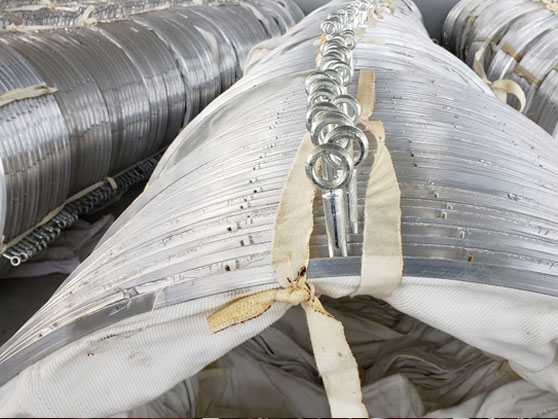The aluminum alloy ring fabric bellow is a specialized dust-proof and material-guiding connector designed for bulk loading systems (e.g., cimento, fly ash, grãos, chemicals, etc.). It features wear resistance, high-temperature tolerance, excellent sealing, and flexible expansion/compression, making it ideal for dynamic industrial applications.
Constructed with high-strength aluminum alloy rings and durable fabric or rubber materials, it ensures reliable performance in harsh environments.
Caraterísticas principais
Aluminum Alloy Rings
Lightweight yet corrosion-resistant, maintaining structural integrity under repeated movement.
Evenly distributed support prevents collapse or deformation.
Durable Flexible Material
Inner Layer: Abrasion-resistant fabric, polyester, or silicone-coated (temperature range: -30°C to +200°C).
Outer Layer: Anti-static and anti-aging treatment for extended service life.
Superior Sealing Performance
Effectively contains dust, complying with environmental standards (e.g., ISO 14000).
Customizable flanges (round/square) to fit various bulk loaders and discharge outlets.
Flexible Expansion & Compression
Compression ratio up to 1:3, adapting to equipment vibration or misalignment.
Easy installation reduces downtime.
Wide Applications
Suitable for cement plants, power stations, grain silos, and chemical industries (e.g., truck/railcar loading systems).
Especificações técnicas
Parâmetro | Details |
Material | Aluminum alloy rings + fabric/rubber |
Diameter Range | DN100–DN800 (customizable) |
Temperatura | -30°C to +200°C |
Pressão | Atmospheric to slight vacuum (-0.05MPa) |
Expansion Length | Customized (typically 0.5–2m) |
Ligação | Flange, clamp, or bolt fixation |
Guia de seleção
Choose inner liner material based on media type (heat/chemical resistance required).
Confirm operational pressure, temperature, and movement frequency.
Provide interface dimensions (flange standards, diameter) and space constraints.
the comparison between Aluminum Alloy Ring and Iron Ring telescopic Bellow
1. Material Differences
Aluminum Alloy Ring fabric Bellow
Frame Material: Rings or spiral rings made of aluminum alloy (e.g., 6061, 6063).
Caraterísticas: Lightweight, excellent corrosion resistance (ideal for humid/chemical environments), but lower heat resistance (typically ≤200°C).
Aplicações: Food, pharmaceutical, and electronics industries where weight and corrosion resistance are critical.
Frame Material: Flat steel flanges (galvanized or stainless steel).
Caraterísticas: High strength, superior heat resistance (galvanized steel ≤300°C, stainless steel ≤500°C), but heavier weight. Galvanized steel may rust in humid conditions.
Aplicações: High-temperature exhaust, industrial dust collection (e.g., welding fumes, boiler emissions) in heavy industries.
2. Structural Design
Aluminum Alloy Rings
Typically spiral or spaced circular rings embedded internally, offering flexible multi-directional movement.
Wider ring spacing reduces airflow resistance but weaker against negative pressure (prone to collapsing).
Iron Rings
Tightly arranged flat flanges wrapped in abrasion-resistant fabric, providing rigid support and high negative pressure resistance.
Larger bending radius, suitable for linear pipelines or minor displacements, but less adaptable to complex bends.
3. Performance Comparison
Caraterística | Aluminum Alloy Ring fabric Fole | Iron Ring fabric Fole |
Peso | Light | Pesado |
Resistência à corrosão | Excellent (anti-rust/chemical) | Moderate (galvanized needs maintenance) |
Heat Resistance | Medium (≤200°C) | High (stainless steel up to 500°C) |
Resistência à pressão | Low | High (suits high-pressure/vacuum systems) |
Flexibilidade | High (multi-directional) | Medium (axial movement preferred) |
Custo | Higher (aluminum price) | Lower (galvanized steel is economical) |
4. Selection Guide
Choose Aluminum Alloy Rings para:
Lightweight needs, frequent movement, or corrosive environments (e.g., chemical plants, cleanrooms).
Lower temperatures and high sealing requirements.
Choose Iron Rings para:
High-temperature, high-pressure, or vacuum conditions (e.g., boilers, metallurgy, mining).
Budget constraints with controlled humidity (galvanized requires periodic maintenance).
5. Additional Notes
Fabric Options: Both types can use various linings (e.g., silicone fiberglass, PTFE-coated fabric) based on medium compatibility (abrasion/chemical resistance).
Instalação: Steel flanges often require bolted flanges, while aluminum rings allow quick clamp mounting.
For optimal performance and lifespan, evaluate temperature, pressure, medium, and displacement requirements when selecting materials and structures.


